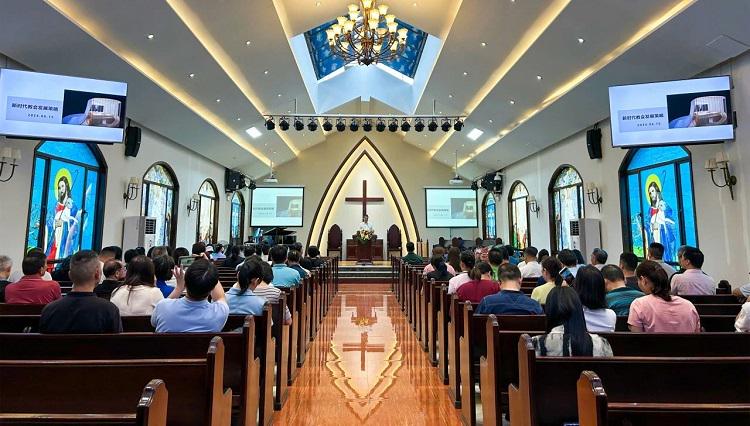In his book Let the Church be the Church: an Ecclesiology, Professor Lin Hong-Hsin of Systematic Theology and Philosophy at the Taiwan Theological College portrays the church as “a living faith community, hence organic.” The original intention of the church is to gather people called by God, forming a specific and vibrant faith community. “In short, the church is ‘alive,’ and living beings necessarily exist within their environment, experiencing interactions with each other and forming close relationships with their surroundings,” says an excerpt from the book (page 12).
Through my encounters with various churches, I deeply resonate with Professor Lin’s perspective of treating the church as a living entity. China boasts a myriad of church forms, shaped by historical traditions, geographical environments, local cultural characteristics, economic development levels, and prevailing social moods, making it impossible to exhaustively enumerate them all. However, from the perspective of a living organism, I categorize churches into three types: those that develop healthily, those struggling with transformation, and those in decline or complacency. The names and locations of the churches mentioned below have been obscured for safety reasons.
Y Church in North China: Responding to the needs of the times by focusing on marriage relationships
Y Church has grown into a medium-sized urban church with three to four hundred members and comprehensive ministries over the past decade. It originated as a gathering place for a dozen people in a pastor’s home. During the three-year COVID-19 pandemic, it maintained uninterrupted worship services, continuous contributions, and no loss of members. The vitality of Y Church stems from the lead pastor’s philosophy: the church must grasp societal trends and contemplate how to respond to the issues of the times.
The pastor identified marriage relationships as the breakthrough point. Believing that marital issues have become one of society’s most pressing problems, he argued that the church should use biblical truths to guide suffering marriages toward establishing correct relationships and restoring God’s original intention for marriage. The pastor and his wife first set an example with their own marriage, and the church subsequently established marital fellowships, with smaller groups within. Group gatherings, family worship services across the church, and courses and activities specifically targeting families, husbands, and wives were organized to share biblical perspectives on marriage, aligning marital beliefs with biblical truths. During the pandemic, when gatherings were restricted, new marriage courses and learning methods were introduced, achieving remarkable results throughout the church.
By focusing on marital issues, Y Church attracts numerous families eager for change in their marriages. The ministry becomes the backbone of the church. From these families, a cohort of core fellow workers emerges, assisting the church in various ministries. One-third of Y Church’s believers are volunteers, and over 90% of these volunteers are couples.
Southern X Church: Rooting the gospel in local conditions
X Church, which began with a dozen believers in a member’s home, has flourished over two decades into a congregation of over three hundred worshippers in a county town. Its growth journey encompassed purchasing a church building, registering, nurturing theological students, establishing church structures and ministries, constructing a new sanctuary, and refining pastoral care and evangelism. Throughout this journey, one principle remains steadfast: grounding everything in local circumstances.
The gospel arrived late in X Church’s area, where traditional folk culture flourished, and local understanding of the gospel was limited. A significant portion of the population hold misconceptions about Christianity, associating it with conservatism, backwardness, and unscientific beliefs, making gospel dissemination challenging. Consequently, the young pastor couple primarily responsible for the church adapts their approach based on local conditions.
Recognizing the generally shallow spiritual lives of believers, the Sunday worship service has been shortened from the full-day gatherings common in older gospel regions to half-day sessions, allowing congregants to focus more intently on the sermon. Rather than adopting conventional discipleship training programs, the church prioritized evangelistic outreach. This dual approach facilitates the growth of believers through the ministry and welcomes seekers into the church to learn about the gospel. The church organizes dinner gatherings, initially minimizing formalities and fostering a relaxed, friendly atmosphere. The gatherings feature interactive and engaging classes that encourage discussion and exchange, rather than one-way teaching from the pastor. “Even if they just come for dinner,” the pastor candidly remarked, “at least they’ll know what the church is doing and help dispel misunderstandings and barriers.” The church’s architecture also aligns with this goal, lacking tall walls, enabling passersby to glimpse inside and dispel notions of mystery and exclusivity.
Z Church in Eastern China: Paralleling group ministry and discipleship training for Christ
Z Church, situated in a county with a deep gospel foundation, economic prosperity, and a large congregation, serves as an ideal model for pastors. Despite its numerous advantages, the pastoral team remains vigilant, remembering the Great Commission and dedicating church resources to “making disciples.”
Z Church operates a parallel system of “small groups plus discipleship training,” with services structured as “small groups plus ministry work.” Groups function as homes, discipleship training as schools, and ministry work as job placements. Within groups, group leaders assume parental roles, fostering deeper personal and emotional connections rooted in the word of God. The church oversees discipleship training, with group leaders directing members to appropriate “classes” based on their spiritual maturity, aiding in the assimilation of learned content. Similarly, group leaders recommend members for various ministry roles based on their gifts. This healthy interplay between groups, discipleship training, and ministry work fosters continuous spiritual growth among believers.
Z Church defines a disciple as someone capable of leading a group. In its operational framework, groups serve as the pivot. Group leaders or disciples are considered spiritual parents, nurturing spiritual lives. Their responsibility is to help group members build their lives until they too can “become parents,” leading new groups.
Northern B Church: Shifting from maintenance to refined pastoral care
B Church, an established congregation in a county town, is renowned for its large attendance and advanced management systems. Since the 1990s, the church has gradually established comprehensive financial and personnel management systems, enabling it to operate smoothly under the guidance of previous generations’ frameworks.
However, the pandemic led to the loss of nearly one-third of its members. The church’s laissez-faire approach to pastoral care, where seasoned and new believers listened to the same sermons, became evident amidst the vast sanctuary and numerous gatherings. Two primary factors contributed to this issue: an inadequate pastoral team and a complacent mindset among pastors.
B Church refuses to continue on the path of visible decline. The first step towards change was a shift in the mindset of its pastors: acknowledging the church’s problems and fostering a desire for change. Following the pandemic, when churches across regions engaged in frequent exchanges and interactions, B Church was inspired to embark on a learning journey. Prior to departure, the leading pastor instructed the accompanying members to document the difficulties they faced in their respective ministries, ensuring they traveled with questions in mind. Upon return, the pastoral team convened for a summation meeting, where an atmosphere of renewed energy prevailed as they actively formulated strategies to address inadequacies in pastoral care.
Firstly, B Church initiated training programs for its volunteer leaders. Secondly, it prioritized the pastoral care of young adults, addressing issues such as career, marriage, and mental health. Through these visits, B Church forged closer ties with other churches, laying the groundwork for deeper cooperation in the future and initiating plans for new ministries.
Northern D Church: Steadfast innovation driving the church through the choir
Nestled in a region with a relatively short history of gospel outreach, D Church stands as the largest congregation in the area, with approximately 800 to 900 believers. However, it confronts a challenge common to many churches: an aging membership and a decline of young people.
Undeterred, the pastor of D Church remains steadfast, focusing on foundational work while seeking steady progress. The priority lies in delivering compelling sermons that enhance the quality of Sunday worship. Additionally, volunteers are guided through in-depth biblical studies, fostering deeper spiritual growth. Recognizing the growing number of elderly members, the church strives to provide comprehensive pastoral care and end-of-life support, enriching their church experiences through diverse initiatives, that are continuously explored and refined.
Moreover, the pastor places great emphasis on nurturing young believers, leveraging the choir as a catalyst. After learning choir leadership from a pastor in Shanghai, he segregated choir members with a foundation and eagerness to learn into an advanced class, combining biblical studies with vocal technique training for simultaneous spiritual and professional enhancement. Over time, the choir swelled from 40 to 120 members, necessitating the formation of separate youth and senior choirs. To further elevate choir members’ skills, the pastor invites professional instructors and actively facilitates exchanges with other church choirs. Through the choir ministry, the pastor has ignited the enthusiasm of a segment of young churchgoers.
These five churches serve as mere exemplars within the vast tapestry of Chinese churches, each nurtured by its unique environment and entrusted with a distinct mission. Life does not replicate; rather, it discovers its own path, distinct and fulfilling.
- Translated by Charlie Li












